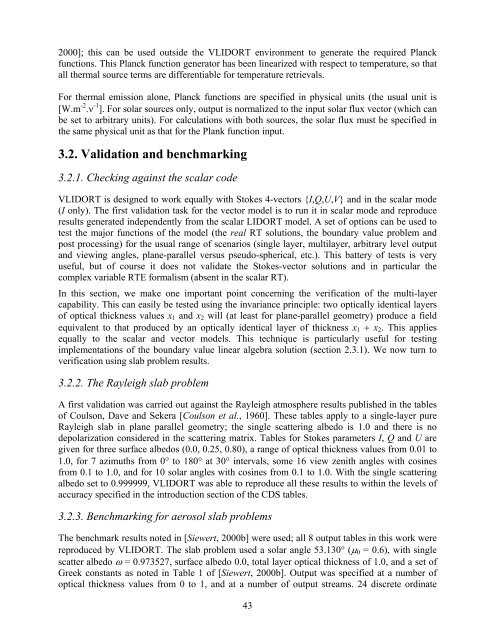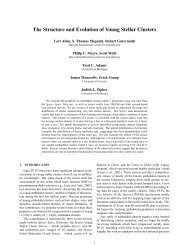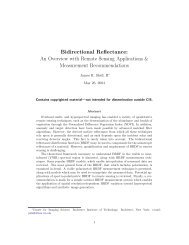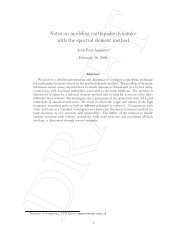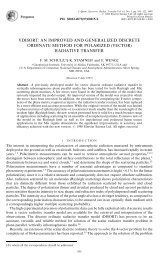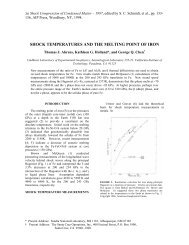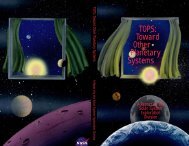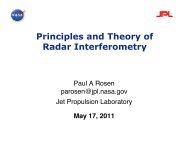VLIDORT User's Guide
VLIDORT User's Guide
VLIDORT User's Guide
Create successful ePaper yourself
Turn your PDF publications into a flip-book with our unique Google optimized e-Paper software.
2000]; this can be used outside the <strong>VLIDORT</strong> environment to generate the required Planckfunctions. This Planck function generator has been linearized with respect to temperature, so thatall thermal source terms are differentiable for temperature retrievals.For thermal emission alone, Planck functions are specified in physical units (the usual unit is[W.m -2 .ν -1 ]. For solar sources only, output is normalized to the input solar flux vector (which canbe set to arbitrary units). For calculations with both sources, the solar flux must be specified inthe same physical unit as that for the Plank function input.3.2. Validation and benchmarking3.2.1. Checking against the scalar code<strong>VLIDORT</strong> is designed to work equally with Stokes 4-vectors {I,Q,U,V} and in the scalar mode(I only). The first validation task for the vector model is to run it in scalar mode and reproduceresults generated independently from the scalar LIDORT model. A set of options can be used totest the major functions of the model (the real RT solutions, the boundary value problem andpost processing) for the usual range of scenarios (single layer, multilayer, arbitrary level outputand viewing angles, plane-parallel versus pseudo-spherical, etc.). This battery of tests is veryuseful, but of course it does not validate the Stokes-vector solutions and in particular thecomplex variable RTE formalism (absent in the scalar RT).In this section, we make one important point concerning the verification of the multi-layercapability. This can easily be tested using the invariance principle: two optically identical layersof optical thickness values x 1 and x 2 will (at least for plane-parallel geometry) produce a fieldequivalent to that produced by an optically identical layer of thickness x 1 + x 2 . This appliesequally to the scalar and vector models. This technique is particularly useful for testingimplementations of the boundary value linear algebra solution (section 2.3.1). We now turn toverification using slab problem results.3.2.2. The Rayleigh slab problemA first validation was carried out against the Rayleigh atmosphere results published in the tablesof Coulson, Dave and Sekera [Coulson et al., 1960]. These tables apply to a single-layer pureRayleigh slab in plane parallel geometry; the single scattering albedo is 1.0 and there is nodepolarization considered in the scattering matrix. Tables for Stokes parameters I, Q and U aregiven for three surface albedos (0.0, 0.25, 0.80), a range of optical thickness values from 0.01 to1.0, for 7 azimuths from 0° to 180° at 30° intervals, some 16 view zenith angles with cosinesfrom 0.1 to 1.0, and for 10 solar angles with cosines from 0.1 to 1.0. With the single scatteringalbedo set to 0.999999, <strong>VLIDORT</strong> was able to reproduce all these results to within the levels ofaccuracy specified in the introduction section of the CDS tables.3.2.3. Benchmarking for aerosol slab problemsThe benchmark results noted in [Siewert, 2000b] were used; all 8 output tables in this work werereproduced by <strong>VLIDORT</strong>. The slab problem used a solar angle 53.130° (μ 0 = 0.6), with singlescatter albedo ω = 0.973527, surface albedo 0.0, total layer optical thickness of 1.0, and a set ofGreek constants as noted in Table 1 of [Siewert, 2000b]. Output was specified at a number ofoptical thickness values from 0 to 1, and at a number of output streams. 24 discrete ordinate43


